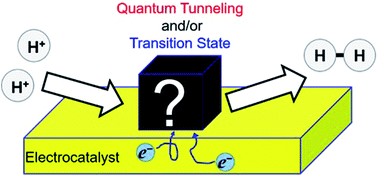当前位置:
X-MOL 学术
›
Faraday Discuss.
›
论文详情
Our official English website, www.x-mol.net, welcomes your feedback! (Note: you will need to create a separate account there.)
Quantum proton tunneling in multi-electron/-proton transfer electrode processes.
Faraday Discussions ( IF 3.4 ) Pub Date : 2019-12-16 , DOI: 10.1039/c9fd00032a Ken Sakaushi 1
Faraday Discussions ( IF 3.4 ) Pub Date : 2019-12-16 , DOI: 10.1039/c9fd00032a Ken Sakaushi 1
Affiliation

|
Quantum proton tunneling (QPT) in two representative multi-electron/-proton transfer electrode processes, i.e. hydrogen evolution reaction (HER) and oxygen reduction reaction (ORR), was investigated using polycrystalline platinum (pcPt) and gold (pcAu) electrodes at 298 kelvin (K). To observe quantum effects in the electrode processes, the hydrogen/deuterium kinetic isotope effect constant ratio (≡KH/D) was measured in various conditions. For the HER in both acidic and alkaline conditions, results show that the pcPt exhibits a negligible or weak QPT evident by the small value of KH/D (1 < KH/D < 3), which indicates that the semiclassical transition state theory (SC-TST) scheme dominates the rate-determining step (RDS). For pcAu in an alkaline condition, the KH/D was a small value of ca. 1 at a low η region around 0.2 V. However, at a high η region >0.6 V, a high KH/D (>13) was obtained. These results suggest a transition of the electrode process from SC-TST to a full QTP in the RDS on increasing the overpotential. For ORR with pcPt, KH/D higher than the theoretical maximum in SC-TST was observed in the alkaline condition at a low overpotential region. A primitive but robust theoretical analysis suggests that the QPT governs the rate-determining step of ORR in this condition. However, this full QPT path transits to the classical in a higher overpotential region. Therefore, contrary to the HER on pcAu in alkaline, the electrode process shows a transition from a full QPT to SC-TST on increasing the overpotential. No QPT in ORR on a pcPt electrode was observed in an acidic condition. This report describes that the QPT in surface electrochemical systems is strongly affected by the choice of system. Although several systems show a clear manifestation of QPT in the electrode processes and also primitive interpretations can be made of these observations, deriving a fine molecular-level picture of the results including several complicated effects remains challenging. However, the observations suggest that selection of a full QPT path might be affected strongly by different microscopic proton transfer mechanisms, i.e. proton transfer from hydronium ion or water molecules.
中文翻译:

多电子/质子转移电极工艺中的量子质子隧穿。
在两个有代表性的多电子/质子转移电极工艺(即放氢反应(HER)和氧还原反应(ORR))中,使用多晶铂(pcPt)和金(pcAu)电极在298研究了质子隧穿(QPT)开尔文(K)。为了观察电极过程中的量子效应,在各种条件下测量了氢/氘动力学同位素效应常数比(≡KH/ D)。对于在酸性和碱性条件下的HER,结果表明pcPt的KPT / D值小(1 <KH / D <3)时,QPT可以忽略不计或弱,这表明半经典过渡态理论(SC -TST)方案主导了速率确定步骤(RDS)。对于碱性条件下的pcAu,KH / D约为ca的小值。1在0.2 V左右的低η区域。但是,在大于0.6 V的高η区域,可以获得较高的KH / D(> 13)。这些结果表明,随着过电势的增加,RDS中的电极过程从SC-TST过渡到了完整的QTP。对于含pcPt的ORR,在碱性条件下低过电势区域观察到KH / D高于SC-TST中的理论最大值。原始但可靠的理论分析表明,在这种情况下,QPT控制着ORR的速率确定步骤。但是,此完整的QPT路径在较高的超电势区域转换为经典路径。因此,与碱性条件下pcAu上的HER相反,电极过程在增加过电势时显示出从完全QPT到SC-TST的转变。在酸性条件下,在pcPt电极上未观察到ORR的QPT。该报告描述了表面电化学系统中的QPT受系统选择的强烈影响。尽管几个系统在电极过程中显示了QPT的清晰表现,并且也可以对这些观察结果做出原始的解释,但要获得包括多个复杂效应在内的精确分子水平的结果图仍然具有挑战性。但是,观察结果表明,选择完整的QPT路径可能会受到不同的微观质子转移机制(即从水合氢离子或水分子转移质子)的强烈影响。得出包括几个复杂效应在内的精细结果的分子图仍然是具有挑战性的。但是,观察结果表明,选择完整的QPT路径可能会受到不同的微观质子转移机制(即从水合氢离子或水分子转移质子)的强烈影响。得出包括几个复杂效应在内的精细结果的分子图仍然具有挑战性。但是,观察结果表明,选择完整的QPT路径可能会受到不同的微观质子转移机制(即从水合氢离子或水分子转移质子)的强烈影响。
更新日期:2019-12-17
中文翻译:

多电子/质子转移电极工艺中的量子质子隧穿。
在两个有代表性的多电子/质子转移电极工艺(即放氢反应(HER)和氧还原反应(ORR))中,使用多晶铂(pcPt)和金(pcAu)电极在298研究了质子隧穿(QPT)开尔文(K)。为了观察电极过程中的量子效应,在各种条件下测量了氢/氘动力学同位素效应常数比(≡KH/ D)。对于在酸性和碱性条件下的HER,结果表明pcPt的KPT / D值小(1 <KH / D <3)时,QPT可以忽略不计或弱,这表明半经典过渡态理论(SC -TST)方案主导了速率确定步骤(RDS)。对于碱性条件下的pcAu,KH / D约为ca的小值。1在0.2 V左右的低η区域。但是,在大于0.6 V的高η区域,可以获得较高的KH / D(> 13)。这些结果表明,随着过电势的增加,RDS中的电极过程从SC-TST过渡到了完整的QTP。对于含pcPt的ORR,在碱性条件下低过电势区域观察到KH / D高于SC-TST中的理论最大值。原始但可靠的理论分析表明,在这种情况下,QPT控制着ORR的速率确定步骤。但是,此完整的QPT路径在较高的超电势区域转换为经典路径。因此,与碱性条件下pcAu上的HER相反,电极过程在增加过电势时显示出从完全QPT到SC-TST的转变。在酸性条件下,在pcPt电极上未观察到ORR的QPT。该报告描述了表面电化学系统中的QPT受系统选择的强烈影响。尽管几个系统在电极过程中显示了QPT的清晰表现,并且也可以对这些观察结果做出原始的解释,但要获得包括多个复杂效应在内的精确分子水平的结果图仍然具有挑战性。但是,观察结果表明,选择完整的QPT路径可能会受到不同的微观质子转移机制(即从水合氢离子或水分子转移质子)的强烈影响。得出包括几个复杂效应在内的精细结果的分子图仍然是具有挑战性的。但是,观察结果表明,选择完整的QPT路径可能会受到不同的微观质子转移机制(即从水合氢离子或水分子转移质子)的强烈影响。得出包括几个复杂效应在内的精细结果的分子图仍然具有挑战性。但是,观察结果表明,选择完整的QPT路径可能会受到不同的微观质子转移机制(即从水合氢离子或水分子转移质子)的强烈影响。



























 京公网安备 11010802027423号
京公网安备 11010802027423号